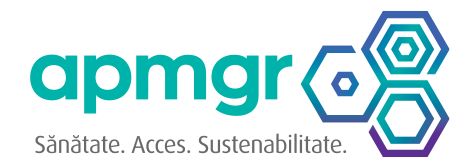- THE NEW TAX COMES BACK TO PREVIOUS FORMULA, UNFAIR, UNPREDICTABLE AND SEVERELY CRITICIZED BY IMF INCLUDED.
- HUNDREDS OF MEDICINE WITH ACCESSIBLE PRICES, USED BY 70% OF ROMANIAN PATIENTS, RISK DISAPPEARING FROM THE MARKET.
- APMGR REQUESTS THAT MEDICINE BELOW 30 RON, PRODUCER PRICE, NOT BE SUBJECT OF CLAW BACK TAX.
- PATIENTS’ ASSOCIATIONS POINT OUT THAT THE CLAW BACK TAX ALREADY LIMITED ACCESS TO TREATMENT FOR ROMANIANS AND ASK THE GOVERNMENT TO TAKE IMMEDIATE MEASURES.
BUCHAREST, AUGUST 28, 2012 – Association of Generic Medicine Producers from Romania (APMGR), association representing the interest of main investors from Romanian market, rejects the new formula of claw back tax adopted by the Government. This becomes an inequitable fiscal burden for generic medicine sector.
After many months of discussions with representatives of pharmaceutical industry, the Romanian Government decided to modify the implementation mechanism of claw back tax in a version maintaining the major deficiencies of previous mechanisms:
- Even though the Government removed the computation formula of VAT, the medicine producers will continue to be obliged to pay an income to the entire distribution chain (including the added price used by distributors and pharmacies).
- The reference amount to which the formula applies does not represent the real consumption of medicine from the previous year;
- It is a return to computation formula from EGO 77/2011 which was extremely criticized by IMF due to INEQUALITY CHARACTER (the tax applies similarly to all producers no matter the medicine sales increase registered by each company ) and UNPREDICTABILITY ( p percentage is not transparent calculated based on wrong data provided by CNAS and the companies cannot anticipate in any way this amount)
“Thenew formula of clawback tax ignores the proposals sent by the generic medicine producers. Therefore, the cut access to medicines at accessible price as well as ruination of local pharmaceutical industry becomes inevitable. The Government continues disrespecting its promises to support generic medicine industry and by new claw back tax formula jeopardizes this field. The new Ordinance returns, retroactively, a new payment obligation for Q 4 /2009. Thereby, there are included penalties for not paying the tax for Q 4/2009, while as per the Application Norms of Law 95/ 2006 (the first version of claw back tax), the contribution payment for claw back applied starting with Q1.2010”, mentioned Laurentiu Mihai, the Executive Director of APMGR.
Producers of medicine with accessible prices experience more strongly the negative impact of claw back tax. Due to the mechanism for calculating the medicine price in Romania, those margins have a more significant weight in case of generic medicine than in the innovative ones. As the applied margins represent together 38% from the shelf price of generic medicine, the producers pay larger amounts under the claw back taxes.
The generics represent, in volume, two thirds from the treatments used nowadays by patients from Romania but the corresponding expenses for those treatments represent fewer than 30% from the total volume of compensated and free medicines.
“Claw back tax has created already many problems to Romanian patients while most of the medicines disappeared from the market. We consider the claw back tax is inequitable applied, punishing the patient by taking them out from the list of the cheap medicine and limiting access to treatment. The government should take immediate measures because in Romania more and more people die due to lack of medicine”, declared Cezar Irimia, the Chairman of the Chronic Patients Alliance from Romania (APCR).
APMGR member companies continue to support the following principles in creating a claw back tax sustainable by the industry:
– A NEW CLAW BACK TAX FORMULA WHICH EXCLUDES FROM CALCULATION THE MEDICINE UNDER 30 RON PRODUCER PRICE. Medicine production with producer price under 30 RON is at risk to be suspended as becomes unprofitable after claw back tax. No company will accept to produce at a loss on medium and long term.
– CALCULATION POINT SHOULD BE THE SELLING PRICE OF THE PRODUCER AND NOT THE PRICE INCLUDING COMMERCIAL ADJUNCTION OF OTHER ECONOMIC AGENTS (WHO ARE NOT AFFECTED BY THE PAYMENT OF THIS TAX)
– THE REFERENCE AMOUNT USED TO CALCULATED THE TAX SHOULD BE THE REAL CONSUMPTION OF COMPENSATED AND FREE OF CHARGE MEDICINE FROM PREVIOUS YEAR
– THE PAYMENT TERM SHOULD BE CORRELATED WITH DEFRAY TERM (RIGHT NOW 300 DAYS IN THE PHARMACIES).
